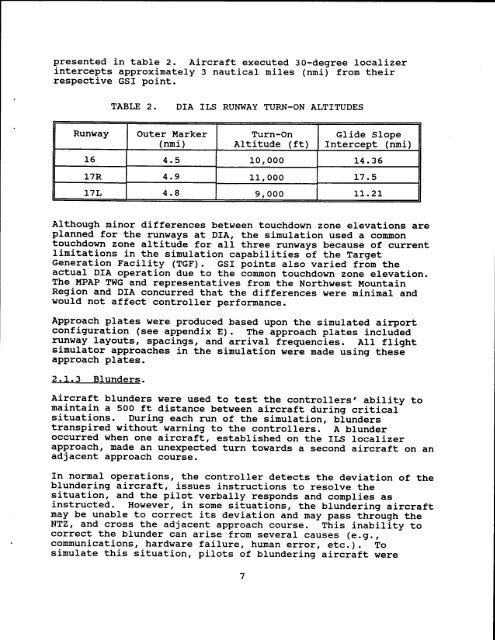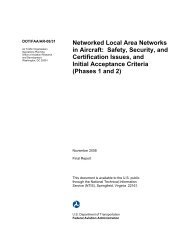Published Report (DOT/FAA/CT-94-36)
Published Report (DOT/FAA/CT-94-36)
Published Report (DOT/FAA/CT-94-36)
Create successful ePaper yourself
Turn your PDF publications into a flip-book with our unique Google optimized e-Paper software.
presented in table 2. Aircraft executed 30-degree localizer<br />
intercepts approximately 3 nautical miles (nmi) from their<br />
respective GSI point.<br />
TABLE 2.<br />
DIA ILS RUNWAY TURN-ON ALTITUDES<br />
Runway Outer Marker Turn-On Glide Slope<br />
(nmi) Altitude (ft) Intercept (mi)<br />
16 4.5 10,000 14.<strong>36</strong><br />
17R 4.9 11,000 17.5<br />
17L 4.8 9,000 11.21<br />
Although minor differences between touchdown zone elevations are<br />
planned for the runways at DIA, the simulation used a common<br />
touchdown zone altitude for all three runways because of current<br />
limitations in the simulation capabilities of the Target<br />
Generation Facility (TGF). GSI points also varied from the<br />
actual DIA operation due to the common touchdown zone elevation.<br />
The MPAP TWG and representatives from the Northwest Mountain<br />
Region and DIA concurred that the differences were minimal and<br />
would not affect controller performance.<br />
Approach plates were produced based upon the simulated airport<br />
configuration (see appendix E). The approach plates included<br />
runway layouts, spacings, and arrival frequencies. All flight<br />
simulator approaches in the simulation were made using these<br />
approach plates.<br />
2.1.3 Blunders.<br />
Aircraft blunders were used to test the controllers' ability to<br />
maintain a 500 ft distance between aircraft during critical<br />
situations. During each run of the simulation, blunders<br />
transpired without warning to the controllers. A blunder<br />
occurred when one aircraft, established on the ILS localizer<br />
approach, made an unexpected turn towards a second aircraft on an<br />
adjacent approach course.<br />
In normal operations, the controller detects the deviation of the<br />
blundering aircraft, issues instructions to resolve the<br />
situation, and the pilot verbally responds and complies as<br />
instructed. However, in some situations, the blundering aircraft<br />
may be unable to correct its deviation and may pass through the<br />
NTZ, and cross the adjacent approach course. This inability to<br />
correct the blunder can arise from several causes (e.g.,<br />
communications, hardware failure, human error, etc.). To<br />
simulate this situation, pilots of blundering aircraft were<br />
7

















